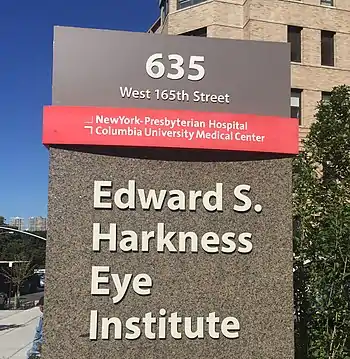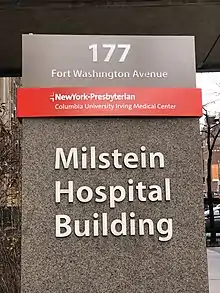| Columbia University Irving Medical Center | |
|---|---|
| NewYork-Presbyterian Hospital | |
 | |
| Geography | |
| Location | Roughly bounded by: west: Riverside Drive north: West 169th Street east: Audubon Avenue south: West 165th Street, Washington Heights, Manhattan, New York City, New York, U.S. |
| Coordinates | 40°50′28.3″N 73°56′26.9″W / 40.841194°N 73.940806°W |
| Organisation | |
| Funding | Non-profit hospital |
| Type | Teaching |
| Affiliated university | Columbia University NewYork-Presbyterian Hospital Harlem Hospital Center New York State Psychiatric Institute Bassett Healthcare, Cooperstown, NY Helen Hayes Hospital Lawrence Hospital James J. Peters VA Medical Center Stamford Hospital The Valley Hospital American Hospital of Paris Ben-Gurion University of the Negev |
| History | |
| Opened | 1767 |
| Links | |
| Website | cuimc |
| Lists | Hospitals in U.S. |
NewYork-Presbyterian/Columbia University Irving Medical Center (NYP/CUIMC), also known as the Columbia University Irving Medical Center (CUIMC), is an academic medical center and the largest campus of NewYork-Presbyterian Hospital. It includes Columbia University Vagelos College of Physicians and Surgeons, College of Dental Medicine, School of Nursing and Mailman School of Public Health, as well as the Morgan Stanley Children's Hospital, the New York State Psychiatric Institute, the Audubon Biomedical Research Park, and other institutions.
The campus covers several blocks—primarily between West 165th and 169th Streets from Riverside Drive to Audubon Avenue—in the Washington Heights neighborhood of Upper Manhattan, New York City.
History
CUIMC was built in the 1920s on the site of Hilltop Park, the one-time home stadium of the New York Yankees. The land was donated by Edward Harkness, who also donated most of the financing for the original buildings. Built specifically to house a medical school and Presbyterian Hospital, it was the first academic medical center in the world. Formerly known as the Columbia-Presbyterian Medical Center (CPMC), the name change followed the 1997 formation of NewYork-Presbyterian Hospital, a merger of two medical centers each affiliated with an Ivy League university: Columbia-Presbyterian with Columbia University, and New York Hospital-Cornell Medical Center, with Cornell University's Weill Cornell Medical College.
The Medical and Graduate Education Building was designed by architects Diller Scofidio + Renfro and Gensler and the structural engineer was Leslie E. Robertson Associates.[1]
In September 2016, the campus was renamed for one of the hospital and the university's largest benefactors, Herbert and Florence Irving.[2] Herbert Irving was a co-founder and former vice-chairman of Sysco.
The hospital completed the first successful heart transplant in a child,[3] the first use of the anti-seizure medication, dilantin, to treat epilepsy,[4] and the isolation of the first known odour receptors in the nose.[5]
The institution supported discoveries related to how memory is stored in the brain, and Nobel Prize-winning developments in cardiac catheterization (1956) and cryo-electron microscopy (2017).[6]
On July 25, 2023, former Columbia OBGYN Robert Hadden was sentenced in federal court to concurrent 20-year sentences for enticing and inducing women, including one minor, to travel to his offices from other states to engage in illegal sex acts. Per the Adult Survivors Act, a New York law that opened a temporary window for victims of abuse to file civil suits against their abusers, even when a statute of limitations has expired victims have until November 23 to file such a lawsuit.
Gallery

 Entrance to the Columbia University Vagelos College of Physicians and Surgeons
Entrance to the Columbia University Vagelos College of Physicians and Surgeons
 Hammer Health Science Center
Hammer Health Science Center Irving Cancer Research Center
Irving Cancer Research Center Russ Berrie Medical Science Pavilion
Russ Berrie Medical Science Pavilion Vivian and Seymour Milstein Family Heart Center
Vivian and Seymour Milstein Family Heart Center Edward S. Harkness Eye Institute
Edward S. Harkness Eye Institute Milstein Hospital Building
Milstein Hospital Building.jpg.webp)
References
Notes
- ↑ Nadine M. Post (March 24, 2015), Mind-Bender In Upper Manhattan Engineering-News Record. Retrieved October 24, 2019.
- ↑ "Columbia University and NewYork-Presbyterian Announce Naming of Medical Campus for Herbert and Florence Irving". PRNewswire. September 21, 2016. Retrieved October 24, 2019.
- ↑ Evans, Heidi (April 13, 2003). "TALK ABOUT A GUY WITH A LOT OF HEART 1st kid to get new ticker wants to be doc". New York Daily News. Retrieved October 24, 2019.
- ↑ Friedlander, W. J. (1986). "Putnam, Merritt, and the discovery of Dilantin". Epilepsia. 27 Suppl 3: S1–20. doi:10.1111/j.1528-1157.1986.tb05743.x. ISSN 0013-9580. PMID 3527690. Retrieved 28 March 2023.
- ↑ Axel, Richard. "SCENTS AND SENSIBILITY: A MOLECULAR LOGIC OF OLFACTORY PERCEPTION" (PDF). Nobel Lecture. The Nobel Prize Committee. Retrieved 28 March 2023.
- ↑ Bec Crew (August 27, 2019). "The top 5 healthcare institutions for scientific research in 2018". Retrieved October 24, 2019.
